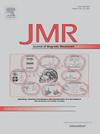一种基于体积解耦谐振器的双侧无线收发线圈,用于临床磁共振乳房x光检查
IF 1.9
3区 化学
Q3 BIOCHEMICAL RESEARCH METHODS
引用次数: 0
摘要
无线射频线圈为各种磁共振应用提供了有价值的低成本解决方案,因为它有几个优点,例如无电缆连接和与不同供应商的磁共振平台兼容。即,用于临床高场人体乳房成像的无线收发器线圈有几种,它们的工作原理都是基于与人体线圈的电感耦合。这些线圈通常由几个体积谐振器组成,用于双侧乳房成像。由于体积谐振器的电邻近位置,观察到强的电感耦合,导致混合模式的发生。原则上,由于B1+分布的均匀性,使用其中一种混合模式的MR成像是可能的。然而,体积谐振腔耦合对无线线圈发射效率和接收灵敏度的影响问题,以往没有研究过。通过这项工作,我们对这一问题进行了研究。开发了第一个具有解耦谐振器的无线线圈,并对其进行了数值和实验评估,包括对健康志愿者的体内研究。此外,通过传统的接收阵列获得体内图像,与开发的无线线圈进行比较。结果表明,采用该结构的一对解耦亥姆霍兹谐振器的发射效率和接收灵敏度比一对相同耦合谐振器的发射效率和接收灵敏度至少提高24%。使用六通道接收阵列也获得了体内图像,以与开发的无线线圈进行比较。与多通道接收阵列相比,所设计的无线线圈的信噪比降低了10%,扫描时间提高了68%。本文章由计算机程序翻译,如有差异,请以英文原文为准。

A wireless bilateral transceiver coil based on volume decoupled resonators for a clinical MR mammography
Wireless radiofrequency coils offer a valuable low cost solution for various MR applications due to several benefits, such as cable-free connection and compatibility with MR platforms of different vendors. Namely, for the purpose of clinical high-field human breast imaging several wireless transceiver coils are known to the date, those operational principle is based on inductive coupling with a body coil. These coils are commonly consist of a several volume resonators to perform bilateral breast imaging. Due to the electrically close location of volume resonators, strong inductive coupling is observed, resulting in the occurrence of hybrid modes. In principle, MR imaging using one of the hybrid modes is possible provided by the homogeneity of a distribution. However, the question of influence of volume resonators coupling on wireless coil transmit efficiency and receive sensitivity was not previously studied. By this work, we performed study to understand this issue. The first wireless coil with decoupled resonators is developed, evaluated numerically and experimentally including in vivo study on healthy volunteers. Additionally in vivo images were obtained by a conventional receive array to compare with developed wireless coil. According to the obtained results, transmit efficiency and receive sensitivity of a pair of decoupled Helmholtz resonators of the configuration under study is at least 24% higher than for a pair of the same coupled resonators. In vivo images were also obtained using a six-channel receive array to compare with a developed wireless coil. Comparison with a multi-channel receive array have shown that SNR of the developed wireless coil is 10% lower, while time scanning was increased by 68%.
求助全文
通过发布文献求助,成功后即可免费获取论文全文。
去求助
来源期刊
CiteScore
3.80
自引率
13.60%
发文量
150
审稿时长
69 days
期刊介绍:
The Journal of Magnetic Resonance presents original technical and scientific papers in all aspects of magnetic resonance, including nuclear magnetic resonance spectroscopy (NMR) of solids and liquids, electron spin/paramagnetic resonance (EPR), in vivo magnetic resonance imaging (MRI) and spectroscopy (MRS), nuclear quadrupole resonance (NQR) and magnetic resonance phenomena at nearly zero fields or in combination with optics. The Journal''s main aims include deepening the physical principles underlying all these spectroscopies, publishing significant theoretical and experimental results leading to spectral and spatial progress in these areas, and opening new MR-based applications in chemistry, biology and medicine. The Journal also seeks descriptions of novel apparatuses, new experimental protocols, and new procedures of data analysis and interpretation - including computational and quantum-mechanical methods - capable of advancing MR spectroscopy and imaging.

 求助内容:
求助内容: 应助结果提醒方式:
应助结果提醒方式:


